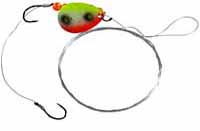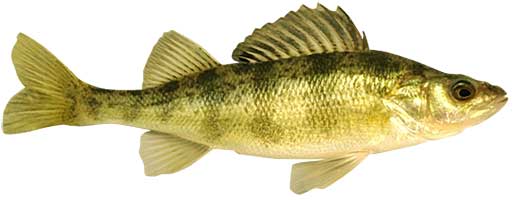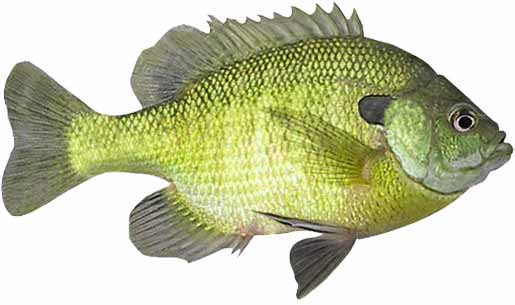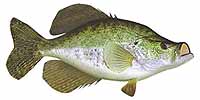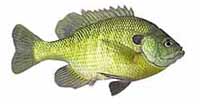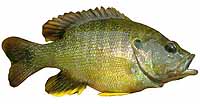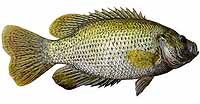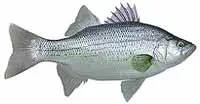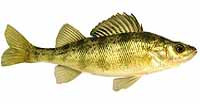Fishing Report For Big Stone Lake, MN
By Rick Seaman
Last updated on .

Fishing Reports
Popular Fish Species Big Stone Lake, MN
Walleye
Current Report: Good
FALL. Fall brought cooler temperatures to shallow water, drawing walleye and baitfish shallower. Now they have moved out to deeper water again, into 8 to 14 feet of water. Walleye continue to be a major draw for anglers. Locals report catching nice walleye on long points, flats along the river and creek channels, and structure off shore. Jigs, swimbaits, spoons, crankbaits, jerkbaits, and spinnerbaits are all historically good for catching walleye this time of year. Early and late in the day finds them in 12 to 16 feet of water. Dragging jigs, bottom bouncers, or worm harnesses with nightcrawlers or leeches, around ledge drop-offs catches walleye fairly consistently. Watch for the bigger walleye to be slightly deeper than the majority of the school.
WINTER. Locals are reporting a lot of big walleye are being caught in Big Stone Lake, especially in winter. This Winter, fishing for walleye has been pretty good through the ice, as it has been for the last few years. Before, during and after the ice, anglers report catching them in the main basin area, in 6 to 14 feet of water, along deep creek channel edges, rocky humps and ledges. Steep drops in the area toward the dam are also producing during these cold months. They primarily feed on small fish, staying close to the bottom. After ice-out blade baits, jigs, swimbaits, spoons, deep-diving crankbaits, and worm harness spinners, all work while deep trolling or drifting.
SPRING. Early Spring brings warming water in the shallows, and draws walleye here to feed, especially rocky areas and inlet channels. In Spring work points, drop offs, submerged structure, rock ledges, flats and flats adjacent to deeper water. Here, in 2 to 8 feet deep, they will spawn once the water warms to the mid to high 40's. When they move shallow, bright colored jigs, tipped with minnows or nightcrawlers typically catch them. Spinnerbaits, jerkbaits and crankbaits are also working when walleye are up shallow. Afterwards, they move to 10 to 12 feet deep around points, island chains, points flats, shoals and ledges, where walleyes stage and feed. They often stay in close proximity to their spawning locations. Main lake drop offs are producing nice fish.
SUMMER. Walleye are light sensitive, so in Spring and early Summer they prefer murkier water when feeding shallow, in rocky and weedy areas. Water temperatures rise in Summer, and walleye fishing is good if you can get your bait deep enough. Early in Summer, walleye tend to concentrate in 8 to 14 feet of water. Throughout Summer, early in the morning, and from dusk to long after dark are good times to catch walleye. At those times they move slightly shallower to feed in low-light conditions. Night fishing is often good in Summer, as well. The rest of the time they are cruising flats and deep creek channel edges, preferring the cooler temperatures. When the bite is slow, grubs and nightcrawlers, fished just off the bottom typically catch walleye.
Yellow Perch
Current Report: Good To Very Good
FALL. As Fall is working its way toward Winter, anglers are finding yellow perch feeding aggressively in 6 to 12 feet of water, especially around weed lines and drop offs. In front of Big Stone Lake State Park is a popular area. Later in the Fall, they begin migrating toward Winter holding areas, often in 8 to 14 feet of water, around the edges of weedbeds, drop offs along flats, channel edges, and humps. Minnows, spinners, spoons and crankbaits are ideal this time of year.
WINTER. Perch jigs tipped with chunks of nightcrawlers, wax worms, minnows and prepared baits are catching lots of nice yellow perch in Big Stone Lake this year. Through the ice, or fishing after the thaw, these small jigs are a great, basic perch bait. Fishing around the boulders, and curly-leaf pondweed while ice fishing, anglers are reporting nice catches of fat perch. The cold of winter drives perch deeper again in search of food and stable water conditions. Mid-depth flats are ideal Winter holding spots. Early in Winter, perch are caught when they are feeding in weedy areas, in 6 to 12 of water. Later in Winter, as the lake freezes over they descend into 14 feet of water. Fishing for perch through the ice was good again this year, using minnows, mealworms, maggots, and nightcrawlers.
SPRING. Perch spawn in Spring when the water temperature warms to the mid 50's and mid 60's. Anglers are beginning to catch them in 2 to 8 feet of water using minnows, mealworms, maggots, and nightcrawlers. Docks, weed lines, drop offs all attract yellow perch searching for a meal. Later in Spring, they drop into 10 to 12 feet of water. Coves in the Meadowbrook areas have historically delivered nice stringers of perch.
SUMMER. Fat yellow perch here feed primarily on small fish and invertebrates. Spinners, underspins, small crankbaits, mealworms, nightcrawlers and maggots are catching perch in 6 to 14 feet of water. In early Summer, plus the first and last hours of the day ,seek them out in feeding zones, 4 to 8 feet deep. Drop-offs and in areas with submerged vegetation are key feeding spots..
Bluegill
Current Report: Fair To Good
Although bluegill are a primary food source for predator fish in Big Stone Lake, the ones that get too large for predators, tend to grow extra large.
FALL. Cooling, Fall weather dropped the water temperature in the shallows and drove bluegill into deeper water, around 4 to 12 feet deep. Steeper banks and shallow, weedy areas with drop-offs are holding bluegill. Later in Fall, as the shallows get colder, bluegill will move into 8 to 12 feet of water, in the same areas.
WINTER. Cooling shallows have driven the bluegill back to deeper structure with cover, in water ranging from 6 to 12 feet deep. In areas with no cover, anglers are finding them along points and humps with sharp drops into deeper water. When the lake ices over, ice fishing produces good catches. Easy access for ice fishing is avail;able via Bonanza, Meadowbrook, and Ortonville. Most successful anglers are slowing down their presentation in this cold water.
SPRING. In early Spring, bluegill migrate from winter holding areas toward the shoreline areas, and are typically caught around 1 to 6 feet deep. As the water warms to the mid 70's they will begin the spawning ritual, building nests in 1 to 3 feet of water. Many of the bigger bluegill prefer to spawn just slightly deeper, depending on water clarity. After the spawn, bluegill drop 5 or 8 feet deeper. Small spinners and swimbaits, or jigs tipped with small pieces of nightcrawlers are good choices for catching a lot of bluegill in spring. A hook, line, weight and bobber, with small pieces of worms, also catches lots of bluegill.
SUMMER. Following the spawn, most of the bigger bluegill migrate to deeper water, around 6 to 14 feet deep. They prefer rocky or weedy areas, often hanging out on steep, rocky banks where they can move up and down to feed without having to travel a great distance. Small spoons, underspins, and mini-crankbaits are catching some of the bigger bluegill. Earthworms are also catching good numbers. Early and late in the day, anglers catch them in 3 to 6 feet of water.
Fishing Video
Fish species to fish for...
Guide to fishing for largemouth bass, white crappie, walleye, bluegill, green sunfish, rock bass, white bass, yellow perch and northern pike at Big Stone Lake in Minnesota.
 Big Stone Lake, a 12,600-acre lake with nearly 60 miles of shoreline. Thousands of rocks and boulders are on the lake bottom, for which it is named. Fishing for bass, walleye, pike, bluegill and perch is available year round, as ice fishing is a very popular activity in winter.
Big Stone Lake, a 12,600-acre lake with nearly 60 miles of shoreline. Thousands of rocks and boulders are on the lake bottom, for which it is named. Fishing for bass, walleye, pike, bluegill and perch is available year round, as ice fishing is a very popular activity in winter.
Primary fish species to catch
Click images for fishing tips and details about each species.
Today's Weather & Forecast
Fishing Boat Rentals
Click here for fishing boat rentals.
Public Boat Launch Ramps & Landings
Click here for boat ramps.
Fishing License
Click here for a Minnesota Fishing License.
Map - Fishing & Access
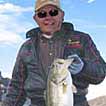 Rick Seaman is a fishing enthusiast with over five decades of fishing experience, a retired tournament fisherman, author of numerous published articles on fishing, and co-author of the book "Bass Fishing - It's not WHAT you throw, It's WHERE you throw it".
Rick Seaman is a fishing enthusiast with over five decades of fishing experience, a retired tournament fisherman, author of numerous published articles on fishing, and co-author of the book "Bass Fishing - It's not WHAT you throw, It's WHERE you throw it".
 Contact Information
Contact Information
Big Stone Lake State Park
35889 Meadowbrook State Park Road
Ortonville, MN 56278
320 839-3663
Fishing lakes in each state
110825
Big Stone Lake, Minnesota Report
MINNESOTA


Information about fishing lakes in MN
Fishing for bass, crappie, walleye, sunfish, perch and northern pike in western Minnesota.



